The Featured Creatures collection provides in-depth profiles of insects, nematodes, arachnids, and other organisms relevant to Florida. These profiles are intended for the use of interested laypersons with some knowledge of biology as well as academic audiences.
Introduction
Of the many beetles inhabiting North America, many collectors favor and seek out those found in the genus Calosoma, particularly the fiery searcher beetle, Calosoma scrutator. This species is especially attractive in appearance with its striking bright, metallic colors, and is one of the continent's largest ground beetles (family Carabidae) (Figure 1). This ground beetle is predatory in both the larval and adult stages, as is typical of the tribe Carabini, thus earning it the common name caterpillar hunter. Ground beetles are the largest family of beetles within the suborder Adephaga with about 200 genera and approximately 2000 species recorded in North America to date (Bousquet 2012).

Credit: Noel Morales via www.bugguide.net
Calosoma scrutator is found primarily in fields and gardens; however, it may also frequent deciduous forests, usually spending the day hiding under logs, rocks, or in crevices, with a preference to hunt at night. It is documented to fly only rarely, but is one of the few species in the genus Calosoma that can climb shrubs and trees in order to forage (Burgess and Collins 1917). Although striking in appearance, these insects should be approached with care. As well as being able to give a nasty bite, most beetles within the genus Calosoma, Calosoma scrutator included, are equipped with scent bladders/glands that can defensively release a fluid with a strong musky odor. The fluid found within these scent bladders/glands contains compounds similar to methacrylic acid and can leave a lingering, unpleasant odor upon contact (Larochelle 1973, Mccullou and Weinheim 1966).
Synonymy
Carabus scrutator Fabricius, 1775
Fabricius first described the fiery searcher in 1775 from type specimens in Virginia. Initially, the species was classified under the genus Carabus until 1801, when Fabricius transferred it to the new genus Calosoma (Burgess and Collins 1917).
Distribution
The fiery searcher has been documented throughout the continental United States, but is most abundant in the eastern states. Additionally, this species has been recorded in southern Canada, Mexico, Guatemala, and Venezuela (Burgess and Collins 1917, Gidaspow 1959). Calosoma scrutator can be encountered in North America from April to November and are most active from May to August (Burgess and Collins 1917).
Description and Life Cycle
Eggs
During the early summer months, female adults deposit single eggs into the soil. The eggs of Calosoma scrutator average 5 mm in length, 2 mm in width, and are oblong, tapered at one end, and white with a slight yellow tinge. They are described as being similar in appearance to other eggs in the genus Calosoma (Burgess and Collins 1917). Depending on the temperature, eggs hatch 3–15 days following oviposition (Burgess and Collins 1917).
Larvae
The larvae develop through three instars. The first instar begins immediately after eggs have hatched. Larvae are robust, about 10 mm in length and about 2.5 mm in width, equipped with tough mandibles, and are initially pale white. First instar larvae remain in the location where they emerged. After an hour or two, the initially pale larvae become darker in color, with dorsal areas and caudal appendages darkening to brown or black and the ventral plates becoming light brown. After the cuticle darkens, larvae emerge from the soil in search of prey. They feed night and day, actively preying on lepidopteran larvae. This first instar typically lasts 3–6 days, depending on temperature and nutrition availability (Burgess and Collins 1917, Gidaspow 1959).
Second instar larvae are larger (about 17 mm in length and 4 mm in width) and look similar to the first instar larvae (Figure 2). During this instar, a small red-brown area at the base of the caudal appendages may appear. This second instar lasts 4–7 days.
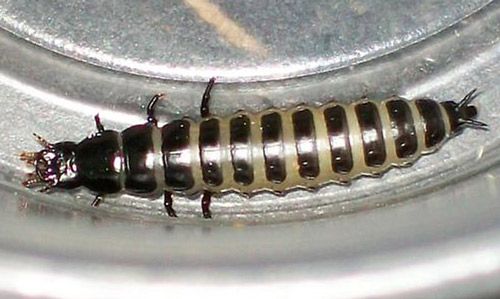
Credit: Noel Morales via www.bugguide.net
The third and final instar larvae are the largest and most robust (about 26 mm in length and 5.5 mm in width). During this stage, the small red-brown area at the base of the caudal appendages becomes more noticeable and pronounced. This stage lasts 9–15 days (Burgess and Collins 1917). In preparation for pupation, the fully-grown larvae burrow (typically 20–25 cm) into a patch of soft soil, where the larvae become contracted, thicker, and form an earthen cell in which to pupate (Burgess and Collins 1917). This process can take up to 7 days.
Pupa
Pupation takes place in the soil, within the earthen cavity constructed by the larva. The pupa is creamy-white during early stages of pupation, after which the extremities of the insect begin to take on the coloration of the eventual adult. Pupation lasts 10–15 days. Newly eclosed beetles dig up to the soil surface where they begin their search for prey and mates (Burgess and Collins 1917).
Adults
The life cycle of Calosoma scrutator (adult to adult) can be completed in a year, but adults are long lived. On average, adults live approximately two years, but have been reported to live for up to four years (Burgess and Collins 1917). Adults are large (25–35 mm long) and robust (11–16 mm wide), with sturdy, striated elytra that are bright, metallic green with reddish gold or purple margins (Gidaspow 1959). The legs are dark blue-violet (Figure 3) (Bostick 1945).
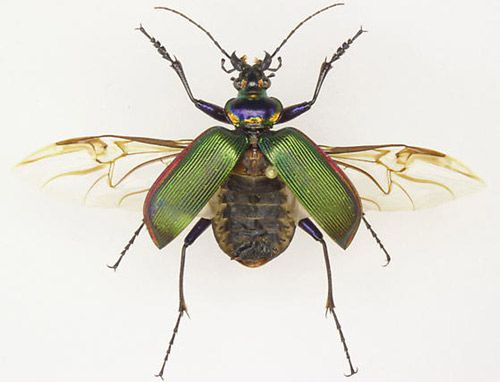
Credit: Frank Guarnieri via www.bugguide.net
The pronotum is short and broad with blue-violet coloration, and is usually bordered in red, gold, and green (Figure 4). The head is mostly black with brown or reddish-brown mouthparts and antennae. The mandibles are curved, pointed at the tips and separated into distal grasping and proximal crushing areas (Figure 4). The mouthparts also contain a large pointed structure at the back of each side (the lacinia on the maxilla), which is used for food manipulation (Bostick 1945, Burgess and Collins 1917). As is typical with most ground beetles, the compound eyes are well developed, but simple eyes (ocelli) are absent.
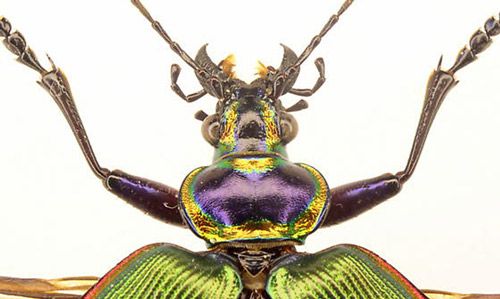
Credit: Frank Guarnieri via www.bugguide.net
Calosoma scrutator males and females can be easily distinguished by comparing the middle tibiae, which are strongly curved and have a patch of reddish setae on the inner surface in males. Females' mid-tibiae are straight and lack this reddish patch (Figure 5) (Burgess and Collins 1917, Gidaspow 1959, Leconte 1862).
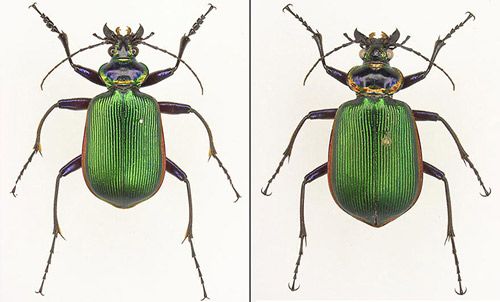
Credit: Frank Guarnieri via www.bugguide.net
Calosoma scrutator is very similar in appearance to a closely related native species, Calosoma wilcoxi, but can usually be distinguished by its larger size (25–35 mm and 18–26 mm, respectively), although overlap in sizes can occur (Figure 6). Additionally, the brush of red setae on the tip of the middle tibiae, present in male Calosoma scrutator, is absent in Calosoma wilcoxi (Gidaspow 1959). These two species can be definitively distinguished by examination of male genetalia (not shown, but see Gidaspow 1959).
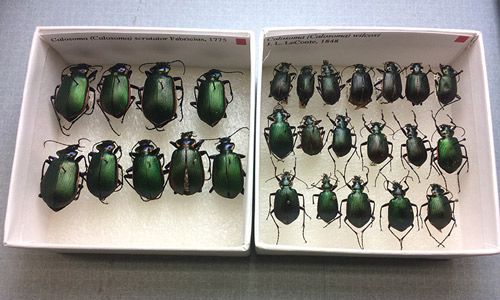
Credit: Ann Marie Carias. Photographed specimens from The Field Museum of Natural History collection, Chicago, IL
Life History
Both the adults and larvae of Calosoma scrutator primarily prey on caterpillars. Specifically, these beetles feed on tent caterpillars (Malacosoma spp.), gypsy moth caterpillars and pupae (Lymantria spp.), as well as larvae of many Noctuidae, Geometridae and other lepidopteran forest species (Burgess and Collins 1917, Coyle 2013). Both adults and larvae climb shrubs and trees in search of prey. An individual larva will consume approximately 50 caterpillars during the three-instar developmental period, and a single adult consumes hundreds of caterpillars during its lifetime (Klots and Klots 1959, Swan and Papp 1972). Laboratory experiments have demonstrated that this species' appetite is not limited to lepidopteran larvae and pupae, but also may include immature Coleoptera and Diptera, although less frequently (Burgess and Collins 1917).
Economic Importance
The fiery searcher is carnivorous and therefore considered beneficial in controlling populations of destructive pests, such as gypsy moths (Lymantria dispar) and tent caterpillars (Malacosoma spp.) (Burgess and Collins 1917, Klots and Klots 1959, Swan and Papp 1972). Their large size, defensive chemicals and mandibles specialized for predation make these beetles top invertebrate predators in forest ecosystems.
Natural Enemies
Insectivorous birds, toads, foxes and skunks are the primary predators of Calosoma scrutator. Other vertebrates, such as raccoons and shrews, have also been documented to feed on these beetles (Burgess and Collins 1917, Giles 1939, Komarek 1932).
Selected References
Bostick B. 1945. The morphology of the carabid beetle Calosoma scrutator (Fabricius). Annals of the Entomological Society of America 38: 14–32.
Bousquet Y. 2012. Catalogue of Geadephaga (Coleoptera, Adephaga) of America, north of Mexico. Zookeys 245: 1–1722.
Burgess AF, Collins CW. 1917. The genus Calosoma: Including studies of seasonal histories, habits, and economic importance of American species north of Mexico and of several introduced species. United States Department of Agriculture Bulletin 417: 1–124.
Coyle D, Pickering J, Dyer KA, Lehman FR, Mohan JE, Gandhi KJK. 2013. Dynamics of an unprecedented outbreak of two native moth species, Cissusa spadix and Phoberia atomaris (Lepidoptera: Noctuidae), on oak trees (Quercus spp.) in the southeastern United States. American Entomologist 59: 82–94.
Gidaspow T. 1959. North American caterpillar hunters of genera Calosoma and Callisthenes (Coleoptera, Carabidae). Bulletin of the American Museum of Natural History 124: 275–314.
Giles LW. 1939. Fall food habits of the raccoon in central Iowa. Journal of Mammalogy 20: 68–70.
Klots AB, Klots EB. 1959. Living Insects of the World. A Chanticleer Press ed. Doubleday, New York.
Komarek EV. 1932. Notes on mammals of Menominee Indian Reservation. Wisconsin Journal of Mammalogy 13: 203–209.
Larochelle A. 1973. Notes on ground beetle odors. The Coleopterists Society 27: 18.
Leconte J. 1862. Notes on the species of Calosoma inhabiting the United States Proceedings of the Academy of Natural Sciences of Philadelphia 14: 52–53.
McCullough T, Weinheimer AJ. 1966 Compounds found in defensive scent fluids of Calosoma marginalis, C. externum, and C. scrutator (Coleoptera - Carabidae). Annals of the Entomological Society of America 59: 410–411.
Swan LA, Papp CS. 1972. The Common Insects of North America 1st ed. Harper & Row, New York.